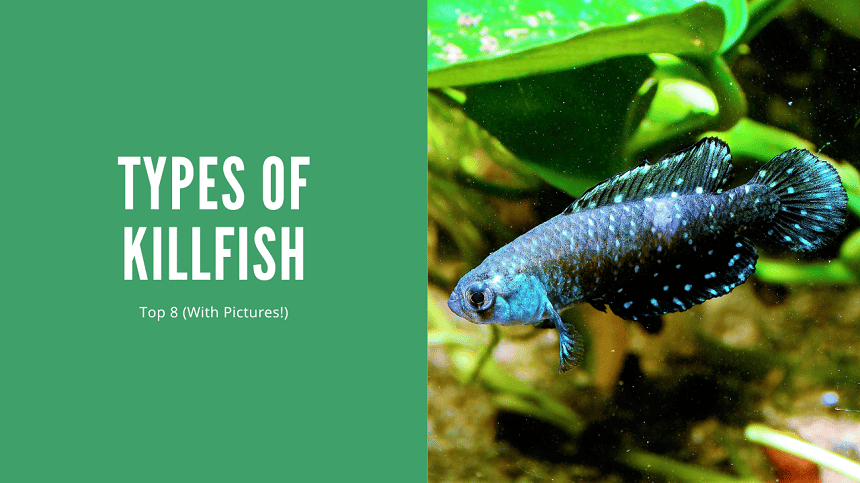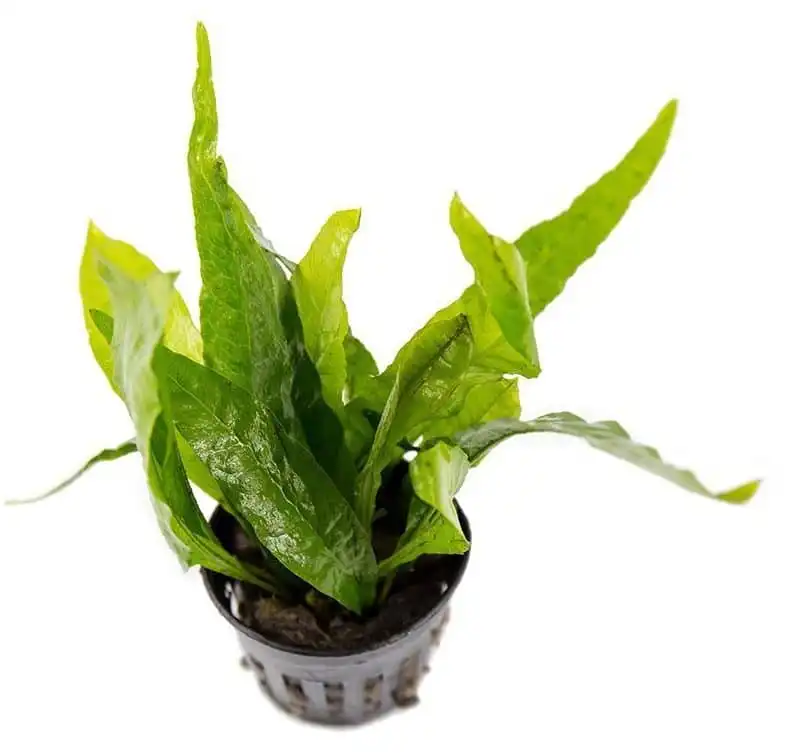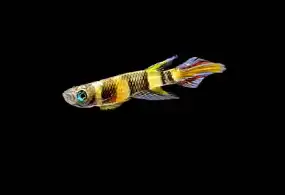Thank you for visiting! By the way… any links on this page that lead to products on Amazon and other stores/partners are affiliate links Aquarium Store Depot earns a commission if you make a purchase.
Are you looking for a new fish to add to your tank? Killifish can be a great choice for any tank, no matter the size. There are many different types of killifish, and each has its own unique personality and features. In this blog post, we will introduce you to the top 8 types of killifish. We’ll include pictures of each type so that you can get a better idea of what they look like. We’ll also discuss some of the pros and cons of keeping killifish as pets. So without further ado, let’s get started!
Key Takeaways
- Killifish are small pretty fish with multiple types available
- Annual Killifish only live for one season while non-annual can live for a few years
- Most species will do fine in tanks under 20 gallons
- The largest Killifish can grow up to 5 inches while the smallest only grows to 1.5 inches
What Is It?
As a child, you might have caught little freshwater fish in a nearby river or stream. More likely than not, these were a type of wild killifish that thrive in calm and densely vegetated environments. But did you know that these fish are available in the aquarium hobby, too?
Killifish have become increasingly popular in the home aquarium over the past few years. With over 1,200 species to choose from for both freshwater, brackish, and saltwater aquariums, these hardy and colorful fish are great fish for beginner, intermediate, and advanced hobbyists alike.
Killifish are largely native to freshwater streams, ponds, lakes, and rivers throughout North and South America though some have adapted to brackish and saltwater conditions. Their range even extends to parts of Southern Europe and into Africa and Asia.
Due to their large range in mostly contained systems, most killifish have adapted to specific niches within their environment. As a result, many of them are extremely hardy aquarium fish.
Unfortunately, one of these adaptations is a short life span. Some species of killifish only live for several months at a time as they are temporary inhabitants of temporary puddles and flood plains.
Are They Hard To Keep In The Aquarium?
Killifish are very easy to keep in the aquarium and are quickly becoming a popular starter fish for beginner hobbyists. This is because these fish are very forgiving of less-than-ideal water conditions and fit into nano tanks under 20 gallons while still being colorful and full of personality; in many ways, these fish are similar to betta fish, but more than one can be kept per tank!
There are some unique challenges that come along with killifish, though. Like betta fish, killifish, especially males, can be overly aggressive towards each other and other fish. Because of this and their preference for lower water temperatures, a high male-to-female ratio needs to be maintained in a species-only setup.
Otherwise, these fish can be pretty shy. They will need dimmed lighting, lots of live plants, and plenty of available hiding spots.
What Is The Biggest Species In Them?
As a type of nano fish, you might be worried that your killifish is underwhelming once you put it into your tank. These are small fish undoubtedly, but there are many sizes to choose from. One of the largest killifish species is the gulf killifish (Fundulus grandis), reaching adult sizes of 6.0-7.0 inches. On average, most killifish available in the aquarium hobby are about 1.5-2.0 inches at full size.
What Is The Longest Living Species In Them?
Sadly, killifish don’t live long. Some are even considered annual species, which means that they hatch, mature, give birth, and die all within the span of one year. This is the result of these fish inhabiting temporary waterways that fill up and dry with the seasons.
As hobbyists, we want fish that will last a long time! If you’re looking for fish that will last a decade, then killifish are not for you. However, some species of killifish can live a relatively long time. These are known as non-annual killifish that live for 2-5 years in permanent waterways.
Care
Killifish aren’t difficult fish to keep in the aquarium, but they do require some unique considerations. That being said, these fish are great for hobbyists at all levels and will reward their owners with spectacular colors and bright personalities.
Tank Size
Most species of killifish are considered nano fish. This means that they’ll comfortably fit into smaller tanks, usually under 20 gallons.
For a 1.5-2.0 inch killifish, a 10-20 gallon aquarium is recommended. If planning to keep more than a single pair of killis, then a larger fish tank is preferred to allow for aggression. Depending on the size of the specific species, more advanced hobbyists have successfully kept a killifish in as little as 5 gallons.
Aquarium Setup
Killifish will show their best colors when they’re completely happy in their aquarium setup. Getting the right setup can be difficult at first, especially if killis are your first fish ever, but it will be one of the most rewarding setups you can design. This is because these freshwater fish heavily rely on live plants for shade and protection.
There are many benefits to keeping live plants in the aquarium, including improved water quality and shelter. Killifish need dense vegetation that lets them hide while providing shade throughout the aquarium. These fish do not tolerate bright lighting, so a dimmed lighting setting plus floating plants will help your fish be more active in the front of the tank.
Killifish need low water movement as they aren’t incredibly strong swimmers. A low water current will also help keep a sand substrate in place without damaging plants.
Driftwood and rocks may be added throughout the aquarium for additional structure.
Filtration And Equipment
Killifish are small fish that don’t typically create a lot of waste. They require average filtration through a sponge filter, hang on the back filter, or canister filter. Larger filters may need to be baffled to keep water movement low throughout the aquarium.
The Best Aquarium Power Filter
The worlds best selling and most reliable power filter on the market. Unchanged for years because it's so reliable and versatile
As we’ll see, some killifish might require a high-protein diet with live food. In these cases, filtration may need to be improved to help keep organics out of the water column. For the most part, the live plants, beneficial bacteria, and frequent water changes will be able to remove excess wastes.
Most killifish species prefer lower water temperatures than other tropical fish. They prefer a water temperature range between 68-75° F. Some hobbyists are able to keep their killifish aquariums without a heater, though we recommend one to keep temperature stable.
Temperature And Other Important Parameters
In addition to a 68-75° F water temperature, killifish prefer relatively neutral pH water conditions between 6.0-7.0. Unlike other colorful tropical fish, killifish do not need extra tannins added to the aquarium for slightly acidic water conditions.
Ammonia and nitrite should always remain at 0 ppm, though these fish will be able to tolerate some traces in the event of an accident. More importantly, nitrates should always remain available to help keep live plants fed. If nitrates are limited, then liquid or dry fertilizers may need to be dosed.
Live Plants And Decorations
Live plants are essential for the success and happiness of killifish. This doesn’t mean that you need to spend a bunch of money for a high-tech setup, though! There are plenty of low-light live plant species that killifish will love, such as Cryptocoryne spp., Anubias spp., and Java fern (Microsorum pteropus). They will especially love floating plants that help dim lighting, like duckweed (Lemna spp.) and water lettuce (Pistia stratiotes).
Java Fern is one of the easiest and hardiest live plants you can purchase
Fake plants can help your fish feel more at home as long as the material doesn’t cause injury. Natural driftwood and rocks are much preferred for a safe biotope setup.
Tank Mates
Killifish are most often kept in species-only tanks in small groups. Though peaceful in temperament, killis can become aggressive during breeding times. Killifish keepers also need to consider that these fish prefer lower water temperatures and water currents than other tropical fish.
That being said, hobbyists successfully keep some types of killifish with other peaceful species. Popular pairings include:
- Corydoras
- Otocinclus
- Danios
- Larger tetras
How Many Should Be Kept Together?
For the best results, a small school of about 2-3 females and 1 male should be kept per tank. Males are very easy to tell apart from females as they are much more colorful and ornate. In order to add additional male killifish to the aquarium, more space will be needed as well as more females.
The ideal tank mates for killifish will be each other. However, killifish aren’t regarded as true schoolers; some species may take part in group activities more than others, but they don’t need to be kept in schools to be happy.
One thing is for sure though and that’s that you don’t want to have too many male killifish in the same tank. Though small, these fish can be very aggressive towards each other, especially during breeding times.
Diet
Killifish are insectivores. This means that the majority of their nutrition comes from insects that land on the water surface and that live on the substrate. In the aquarium, this diet can be difficult to replicate for some hobbyists.
This is mainly due to some killifish refusing to adapt to conventional aquarium foods. It is not unheard of for a killifish to refuse freshwater fish flakes and pellets.
Instead, these fish will need to be given a variety of freeze-dried, live, and frozen foods. They will especially enjoy brine shrimp, mysis shrimp, and a variety of worms. They may also be given mosquito larvae to help stimulate their natural instincts.
Breeding
For a fish that lives less than a year, you might want to learn how to breed them to keep your tank full. Luckily, both annual killifish and non-annual killifish are easy and exciting to breed. Most of the time, these fish are already sold in pairs.
For breeding killifish, it’s recommended to have a separate breeding tank.
First, isolate the male annual killifish you would like to breed as they have the quickest life spans. Place 2-3 females with rounded stomachs alongside him. Place a sunken cup or bowl of peat moss into the breeding tank. The group should spawn over the next day.
To help replicate dry season conditions in their natural habitat, the peat moss with the killifish eggs should be removed, gently squeezed out, and placed between newspapers for 24 hours in a semi-sealed container. After that time has passed, take a small piece of peat moss and place it into the water.
Annual killifish eggs are meant to hatch in batches for the best success of making it through the dry season. If successful, killifish eggs will hatch over the next few days. If no killifish eggs hatch, then re dry the same peat moss for another month or simply respawn your fish. Amazingly, killifish eggs can survive in these dry conditions for up to 3 months. You can check out this video above for how to hatch killifish eggs.
To spawn non-annual killifish, perform the same routine. However, the eggs do not need to be removed from the aquarium and the fry will hatch underwater. It is best to remove the adult fish to prevent loss.
Types
Freshwater killifish, brackish killifish, and saltwater killifish. There’s a killifish for everyone!
Even though these fish are easy to keep, there are some that are more popular than others. This can make it difficult and expensive to find certain ones in local fish stores. However, once you have a pair, you can easily breed them to keep your killifish tank always full!
1. Clown
- Killifish Species: Epiplatys annulatus
- Adult Size: 1.5 inches
- Color: Black and yellow
- Unique Traits: Red and blue tail fin
- Annual or nonannual? Non-annual
Probably the most well-known species of killifish on this list, the clown killifish doesn’t look like your typical killi. The African clown killifish has alternating black and yellow broad stripes which earn them their second name, the banded panchax (video source).
Clown killis are also much smaller than the average killifish, only growing to about 1.0-1.5 inches at full size. Because of this, some hobbyists have had luck keeping them in 5 gallon aquariums.
2. Gardneri
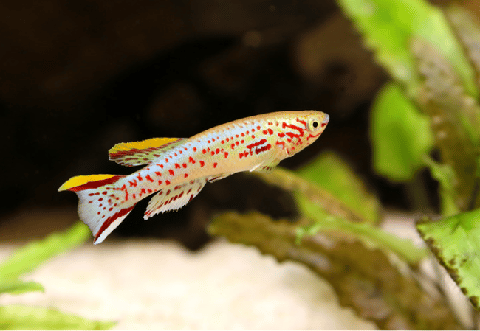
- Killifish Species: Fundulopanchax gardneri
- Adult Sizes: 2.5 inches
- Color: Green, yellow, blue, and red
- Unique Traits: Red spots that cover the body
- Annual or nonannual? Non-annual
The gardneri killifish is a somewhat colorful killifish similar in appearance to the related blue gularis killi. In contrast, gardneri’s are half the size and nowhere near as ornate. However, this African killifish is great for simple setups where appearance doesn’t matter as much.
3. Blue Gularis
- Killifish Species: Fundulopanchax sjostedti
- Adult Size: 5.5 inches
- Color: Blue and red
- Unique Traits: Red spots and stripes, enhanced tail
- Annual or non-annual? Non-annual
One of the larger species of killifish, the blue gularis grows to be about 5.5 inches and is one of the most ornate species available. These fish are native to the rainforests of Nigeria and Cameroon and are immediately identifiable by their speckled appearance.
Blue gularis have an electric blue body that is covered in deep red spots and stripes; sometimes there is so much red that it might look like the body of the fish is red and the markings are blue. Male fish often exhibit a long, ornate tail as well.
4. Lyretail

- Killifish Species: Aphyosemion australe
- Adult Size: 2.5 inches
- Color: Yellow and orange, sometimes blue
- Unique Traits: Red and dark orange stripes and spots
- Annual or non-annual? Non-annual
Aphyosemion australe is commonly known as the golden lyretail or lyretail panchax and was one of the first popular species of killifish in the aquarium hobby. These African fish are beautifully colored with yellows, oranges, and blues, with accents of reds and dark oranges. They have ornate dorsal, anal, and tail fins.
Some other selectively bred varieties exist from this species, including gold, orange, and chocolate colorations.
5. Rachovi
- Killifish Species: Nothobranchius rachovii
- Adult Size: 2.25 inches
- Color: Red and blue
- Unique Traits: Black tail fin margin
- Annual or non-annual? Annual
The rachovi killifish, also known as the bluefin notho, is one of the more popular types of killifish. This fish originates from African flood plains that dry up with the seasons (video source). Because of this, they are annual killifish and will live for less than a year.
6. Florida Flagfish
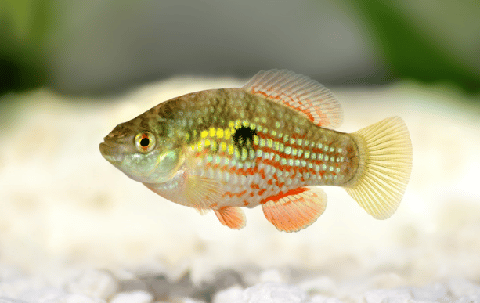
- Killifish Species: Jordanella floridae
- Adult Size: 2.5 inches
- Color: Silver, blue, and orange
- Unique Traits: Algae-eater
- Annual or non-annual? Non-annual
The Florida flagfish isn’t one of the most colorful killifish species available, but they’re endemic to Florida and can make great outdoor pond fish in freshwater or saltwater ecosystems. Florida flagfish are one of the few fish in the aquarium hobby that eats black beard algae.
Interestingly, the Florida flagfish holds the spot for being the fish with the fewest eggs in a clutch, only laying about 20 eggs over the course of several days.
7. Two Stripe Lyretail

- Killifish Species: Aphyosemion bivittatum
- Adult Size: 2 inches
- Color: Rainbow
- Unique Traits: Enhanced fins
- Annual or non-annual? Non-annual
Also known as the rainbow killifish, the two stripe lyretail killifish, is extremely colorful with enhanced fins. These fish are named after the two black stripes that run along the stomach and dorsal fins of both the males and females. They originate from parts of Nigeria and Cameroon in Africa.
Male two stripes can have an array of colors and spots across their bodies, consisting of reds, oranges, yellows, greens, and blues with a silver base coat. Females are mainly silver in color but still feature the two stripes.
8. Golden Wonder
- Killifish Species: Apolcheilus lineatus
- Adult Size: 4 inches
- Color: Silver and yellow
- Unique Traits: Orange spotted and striped body and fins
- Annual or non-annual? Non-annual
The golden wonder killifish, also known as the malabar killifish or striped panchax, originates from India and Sri Lanka. They have been found in freshwater and brackish water conditions and are sometimes used for mosquito control.
Male golden wonder killis are yellow with some silver and blue undertones. They have notable red and orange stripes and spots across their body and fins.
Final Thoughts
For most, a fancy guppy or a betta is the first fish added to the freshwater aquarium. Though more expensive than the typical guppy, killifish are much more colorful and interesting and can do great as the first fish in the aquarium as long as the tank is fully cycled.
Some important requirements to take into consideration are their need for cooler water temperatures and limited tank mate options. Otherwise, they will happily live in a planted nano aquarium for several years.
- About the Author
- Latest Posts
I’m thrilled that you found Aquarium Store Depot! Here you’ll find information on fish, aquariums, and all things aquatics related. I’m a hobbyist (being doing this since I was 11) and here to help other hobbyists thrive with their aquariums! I adhere to a high quality Editorial Process and Review products with real life field usage and practical analysis.

